When it comes to a hearty, delicious roast, two cuts of beef take center stage: Prime Rib versus Rib Roast. Both have pros and cons and are often used interchangeably, but there are marked differences between them. Prime Rib is cut from the cow’s rib section and is considered the most desirable due to its tender, juicy, and flavorful meat. On the other hand, Rib Roast is the name given to any large, bone-in beef cut that includes the rib section, often the boneless “eye” portion. Understanding the nuances of the two cuts can help you make an informed decision at your next family gathering or restaurant visit. So, let’s dive in and explore the differences between Prime Rib vs Rib Roast.
What is Prime Rib?
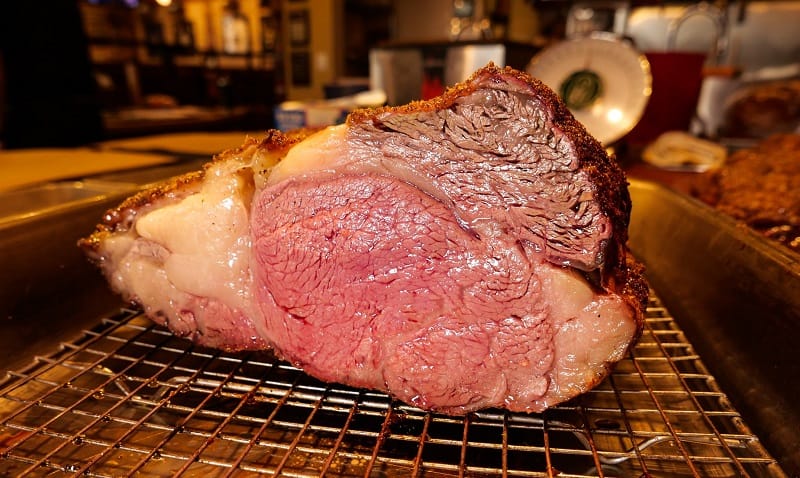
Prime Rib is a cut of beef from the cow’s rib section. It is a larger cut of beef that is usually served in restaurants and on special occasions. It is known for its tenderness, flavor, and juiciness due to the marbling of fat within the meat. Prime rib is typically served with a side of vegetables or potatoes and can be cooked in various ways.
When purchasing prime rib, looking for a cut with a good amount of marbling is important. Marbling is the fat interspersed throughout the meat’s muscle fibers. The more marbling, the juicier and more flavorful the prime rib. It is also essential to look for a prime rib with a good amount of fat cap, which is the layer of fat on the outside of the prime rib. This fat cap helps to keep the prime rib moist while cooking and adds flavor to the meat.
When cooking prime rib, it is best to cook it slowly and at a low temperature. This will help to keep the meat moist and juicy and to prevent it from drying out. Prime rib is usually cooked in the oven, on the grill, or in a slow cooker.
Prime rib is a luxurious and delicious cut of beef that is perfect for special occasions or an extravagant dinner. If you’re looking for a delightful and impressive cut of beef, consider trying prime rib.
What is Rib Roast?
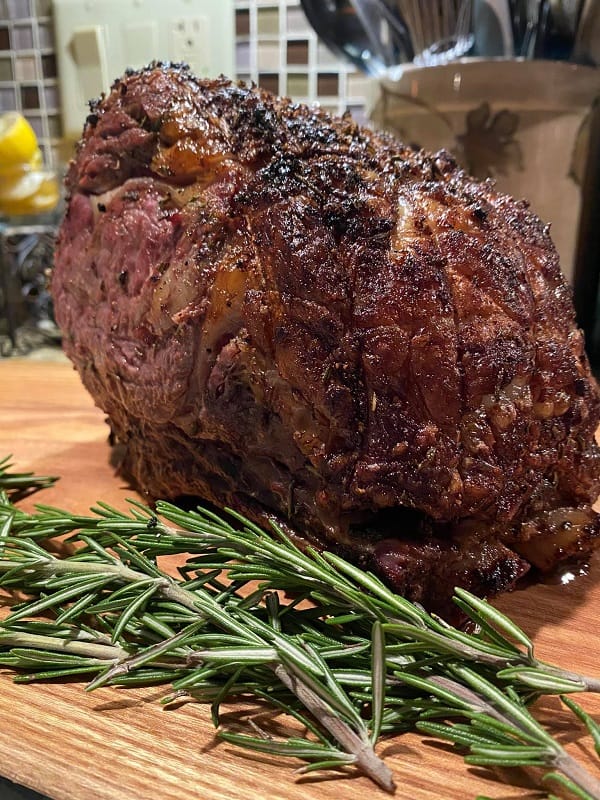
A rib roast is an impressive and delicious beef cut that will make any meal special. The roast comes from the rib section of a cow, usually from the front ribs, and is a tender, juicy cut from the animal’s most premium part. It is a popular choice for special occasions and holiday meals due to its superior flavor and tenderness.
Rib roasts are composed of a few cuts of meat, including ribeye, rib cap, and rib end. The ribeye is the most prized cut and is the most tender, flavorful, and expensive. The rib cap is slightly less juicy but still full of flavor, and the rib end is the most affordable and toughest of the three.
When shopping for a rib roast, look for one that is well-marbled and evenly distributed throughout the cut. This will ensure the roast is tender, juicy, and flavorful. If the rib roast is too lean, the roast will be tough and not as flavorful.
Prime Rib and Rib Roast: What’re The Similarities
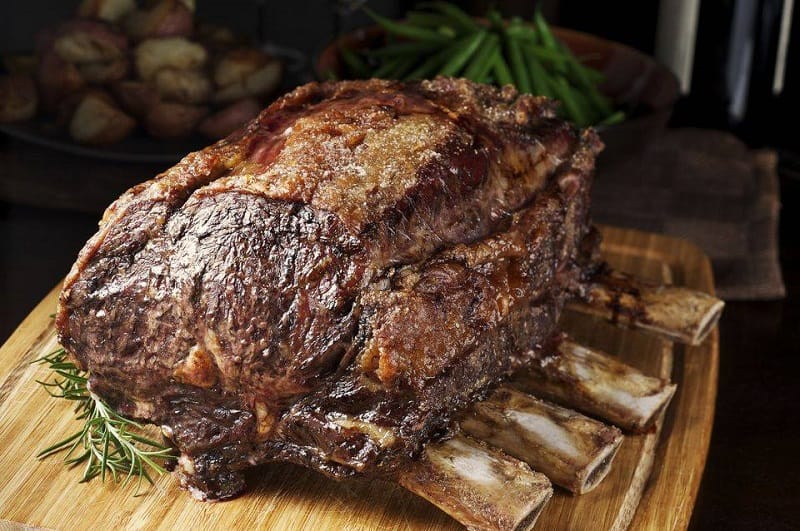
Let’s explore the similarities and differences between prime rib and rib roast to help you decide which cut is best for your upcoming meal.
Prime rib and rib roast come from the cow’s same area, the rib section. This section is located on the animal’s back and contains the seven ribs, which are the ribs closest to the shoulder. The prime rib is the upper part of the rib section, and the rib roast is the lower part. Both cuts are considered some of the most tender and flavorful cuts of beef, which is why they are so popular.
In terms of similarity, both prime rib and rib roast come from the same area of the cow, and both are tender and flavorful cuts of beef. The difference between them lies in the amount of fat they contain. The prime rib contains more fat, giving it a richer flavor and juicier texture. The rib roast has less fat, giving it a leaner texture and flavor.
When it comes to cooking, both cuts can be cooked in the same manner. For instance, both can be roasted, grilled, or simmered. The prime rib is often cooked at a higher temperature than the rib roast, requiring a longer cook time to ensure it is cooked properly. However, the rib roast can also be cooked at a lower temperature for a shorter cook time.
What Is The Difference Between Prime Rib vs Rib Roast
Prime rib is roasted with the bones intact, while rib roast can be cut bone-in or boneless. Prime rib is also a standing roast typically cooked as part of a larger roast. On the other hand, the rib roast is generally cooked as individual steaks. Prime rib is known for its juicy, tender texture, as it is slow-roasted under low heat. In contrast, rib roast steaks are often grilled quickly over high heat. So, whether you prefer a sizzling steak or a succulent roast, there’s a cut of beef for everyone.
Location
Prime rib comes from the rib primal—the rib area of the cow—while rib roast is taken from the chuck primal, a cut of meat from the shoulder and neck area. The rib primal is generally considered more desirable and typically more expensive.
Is One Considered More High-End Or Premium Than The Other?
Prime rib is more premium than rib roast because of the higher quality of the cut and its marbling. Prime rib is usually more expensive to purchase than rib roast, but the flavor and tenderness of prime rib reward the extra cost.
Pricing of Rib Roast vs Prime Rib
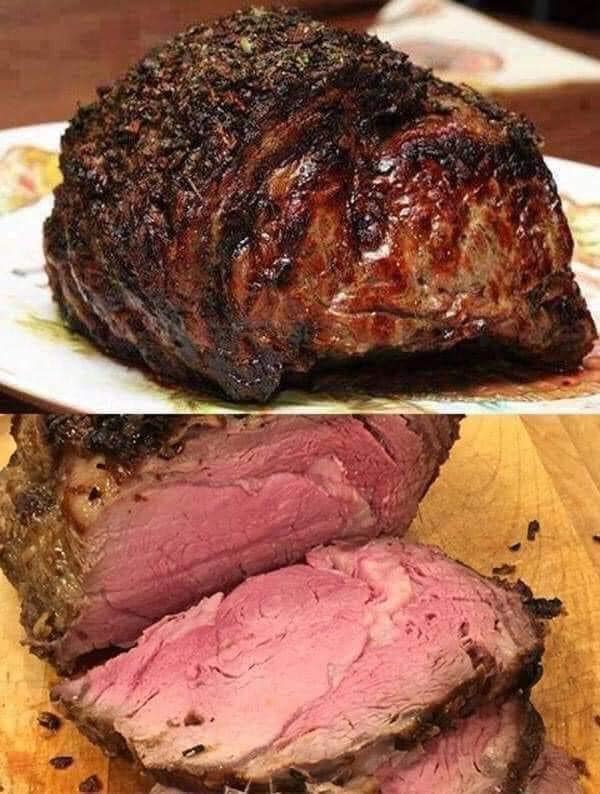
When it comes to pricing, rib roast is usually less expensive than prime rib. However, because prime rib comes from the rib primal and is more desirable, it can still be pricey. The prices can vary greatly depending on the size of the roast and the quality of the beef.
Which One Is Better Suited For A Special Occasion Or Holiday Meal?
Both roasts can be cooked in various ways, making a delicious meal. However, the higher quality cut of meat in prime rib is generally considered the more special or premium option for a celebration. If you’re looking for a roast to serve to guests or a special someone, prime rib is the way to go.
Flavor And Texture
Prime rib is a more tender, juicy cut of beef. It is known for its rich, beefy flavor and is often considered the most flavorful and palatable beef cut. Prime rib also has a higher fat content than rib roast, which gives it a richer, more luxurious texture.
Fat Content
The prime rib has more fat marbling than rib roast. This means that prime rib has a higher percentage of fat in the muscle itself, which adds flavor and juiciness. Rib roast, on the other hand, has less fat throughout the muscle and is generally less flavorful and less juicy.
Calories
When it comes to calories, the prime rib has slightly more calories per serving than the rib roast. This is due to the higher fat content of prime rib. However, the difference in calories is minimal, and both cuts of beef are considered leaner than other cuts of beef.
Rib Cap
Another key difference between prime rib and rib roast is the rib cap. The rib cap is the layer of fat and connective tissue that covers the top of the rib roast. This layer of fat can be removed before cooking, leaving the rib roast with less fat and a leaner texture. On the other hand, Prime rib does not have a rib cap and is, therefore, more tender and juicy.
Bones
Prime rib is typically cut from the cow’s rib section and can include six or seven ribs. Rib roast, on the other hand, is usually cut to include four ribs. This difference in the number of ribs can affect the cooking time and the final flavor of the meat.
Preparation
When it comes to preparation, prime rib is the more expensive of the two. Prime rib is a boneless cut of beef from the rib primal, while rib roast is a bone-in cut that includes both the ribeye and the rib primal. Both cuts require trimming and the removal of the fat cap before cooking.
Cooking Methods
The most common method is roasting when cooking either prime rib or rib roast. Prime rib is often roasted at a lower temperature to ensure the fat is rendered and the meat is cooked evenly. The rib roast is usually cooked at higher temperatures for a crisp, golden-brown crust.
Which Cut Of Meat Is Typically More Tender, Prime Rib Or Rib Roast?
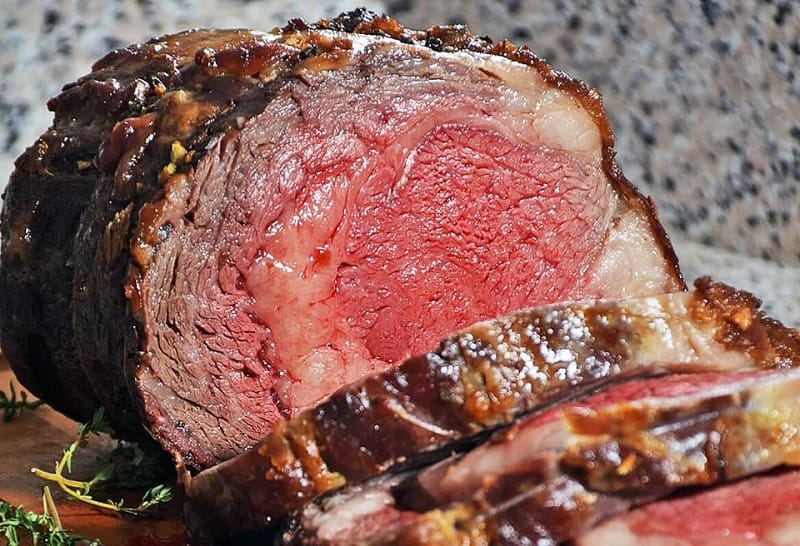
Prime rib is typically more tender than rib roast. The tenderness of the meat depends on the cut and the cooking method used. Prime rib is usually cooked at a lower temperature, which helps keep the meat moist and tender. Rib roast, on the other hand, is usually cooked at a higher temperature, which helps to caramelize the fat and create a crisp, browned outer layer.
Serving Size
Regarding serving size, prime rib is usually larger than rib roast. Prime rib typically comes in cuts of 4-7 ribs, while rib roast is usually just 2-3 ribs. The larger prime rib makes it a better choice for large gatherings or family dinners.
Is Rib Roast or Prime Rib Easier To Cook?
Both prime rib and rib roast require some preparation before cooking. Prime rib requires trimming and removing the fat cap, while rib roast requires trimming and removing the rib bones. Both cuts also require careful monitoring of the cooking temperature to ensure that the meat is not overcooked or undercooked.
Which Is Better – Rib Roast vs Prime Rib?
When it comes to choosing between prime rib and rib roast, it depends on your preferences. Prime rib is usually more tender and flavorful, while rib roast has a crisp, golden-brown crust. Ultimately, the decision comes down to personal preference and what you are looking for in a cut of beef.
Read more:
- Prime Rib Vs Ribeye
- What Part Of The Cow Is Prime Rib
- St Louis Ribs Vs Spare Ribs
- Short Ribs Vs Spare Ribs
- Filet Mignon Vs Ribeye
How To Cook A Rib Roast
Cooking a rib roast is not only a great way to serve a crowd, but it’s also an impressive dish to make. You can make a perfect rib roast that’s flavorful, juicy, and perfectly cooked with a few simple steps.
- Before you start, take the beef out of the fridge two to three hours before cooking to bring it to room temperature. Pat it dry with a paper towel. Then, preheat your oven to 240°C/460°F (220°C fan). Adjust the rack so the beef will sit in the oven’s middle.
- Next, place onion, garlic, and herbs in a heavy-based oven-proof skillet. Spread a thin layer of butter over the underside of the beef (the bone side). Place the beef in the skillet, butter side down. Then spread about two-thirds of the butter over the top and sides of the beef.
- When your oven is hot, let the beef roast for 20 minutes, then remove it and spread the remaining butter over the beef. Turn the oven down to 120°C/250°F (100°C fan).
- Slow roast: Roast the beef for 1 1/2 hours, basting it with the juices in the pan every 30 minutes until the internal temperature is 50°C/122°F in the center. Start checking the internal temperature early.
- Once the beef is done cooking, transfer it to a plate. Cover it loosely with foil and let it rest for 20 to 30 minutes. The internal temperature will rise to 54°C/129°F.
- Finally, slice the beef and serve it with a sauce of your choice. Enjoy!
How To Cook Prime Rib
Learning to cook a perfectly tender, juicy prime rib can seem intimidating. But with a few simple steps, you can achieve restaurant-quality results in your kitchen. Here’s how to cook up a prime rib that will have your friends and family raving:
- Preheat your oven to 350°F.
- Make a paste of shallot, garlic, herbs, oil, pepper, and salt. Rub this mix liberally over the standing rib roast and let sit at room temperature for about 30 minutes before cooking.
- Place your mirepoix in a roasting pan and set the prime rib on the rack, fat side up. This will help season and bathe the roast in its flavorful juices as it cooks.
- Bake the prime rib until its internal temperature reaches 5 to 10° below the desired doneness. This will usually take between 1-3/4 and 2-1/4 hours.
- Once you’ve removed the prime rib from the oven, let it rest for at least 15 minutes before cutting. You may want to let it stand up to 5 minutes longer for larger cuts. This resting period gives the juices time to absorb into the meat.
- Carve the prime rib and enjoy!
Which Cooking Method Yields The Best Results For Prime Rib And Rib Roast?
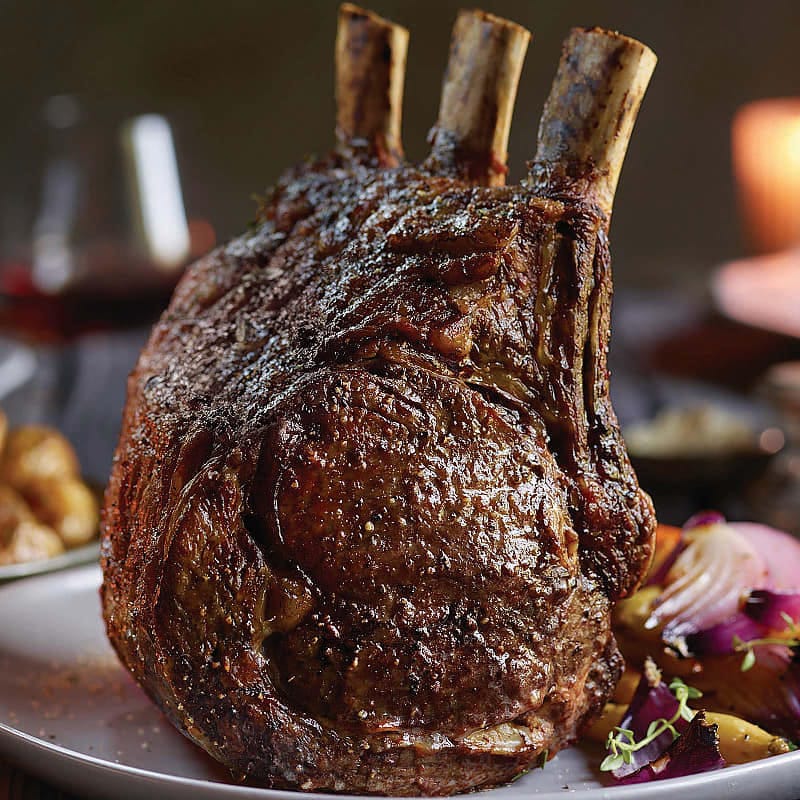
Several cooking methods are suitable for prime rib and rib roast, but some yield better results. We’ll discuss the best cooking methods to prepare prime rib and rib roast.
Roasting is the most popular way to prepare prime rib and rib roast. This method involves placing the roast in a roasting pan or on a rack over a vegetable bed and then slowly roasting it in the oven. This method allows the roast to cook slowly and evenly, resulting in juicy, tender meat. The slow, gentle heat keeps the meat from drying out and allows the fat to render properly. Add herbs, vegetables, and seasonings to the roasting pan before cooking to maximize flavor.
Grilling is another great way to prepare prime rib and rib roast. This method involves placing the roast on a preheated grill and cooking it over medium-high heat. The grill’s intense, direct heat helps create a rich, flavorful crust on the outside of the roast. To further enhance the flavor, add a variety of seasonings and marinades to the meat before grilling.
Searing is yet another option for cooking prime rib and rib roast. This method quickly sears the roast on all sides in a hot skillet. The intense heat helps caramelize the roast’s surface and create a flavorful, crisp crust. To keep the roast from drying out, finish it in the oven, allowing the juices to redistribute throughout the meat.
Finally, braising is excellent for preparing prime rib and rib roast. This method involves slowly cooking the roast in a mixture of liquid, such as broth or wine, and aromatic vegetables, such as onions and garlic. This method tenderizes the meat and helps to enhance the flavor. The braising liquid also helps to keep the roast moist, preventing it from drying out.
What Is The Proper Resting Time For Both Cuts Of Meat?
If you’re looking for the perfect prime rib or rib roast for the holiday season, it’s essential to understand the proper resting time for each cut of meat. Resting time is the amount of time that a roast should sit out before carving, and it can make a huge difference in the texture and flavor of your roast.
When it comes to prime rib, the resting time should be around 15 minutes. This will allow the juices to settle and the fibers to relax, making it easier to carve and ensuring the juiciest, most flavorful cut of meat. Covering the roast with a sheet of foil during resting time is important to prevent it from cooling off too quickly.
For rib roast, the proper resting time is a bit longer – around 20 minutes. This is because the fat between the ribs needs to relax before slicing. Again, it’s important to cover the roast with a sheet of foil during resting time to help keep the roast from cooling off too quickly.
How To Select The Best Rib Roast And Prime Rib
When selecting the best rib roast and prime rib, there are several factors to consider. The first is the cut of meat you’re looking for. If you’re looking for a more tender, juicy rib roast, you’ll want to look for a center-cut roast. This cut will have the most marbling and is the most tender. On the other hand, if you’re looking for a more substantial roast, you’ll want to look for a rib-eye roast. This cut will have a higher fat content and be more flavorful.
Another factor to consider is the grade of the rib roast or prime rib. Prime rib will always have the most marbling and the highest fat grade, making it the most flavorful and expensive. On the other hand, choice grade roasts will have more marbling and fat than select grade, but not as much as the prime grade.
When it comes to the rib roast or prime rib size, there are a few things to consider. The size of the roast or prime rib will depend on the number of people you’re serving and the size of the cut. Smaller roasts or prime ribs will be more tender, while larger roasts or prime ribs will be more flavorful.
Finally, when selecting the best rib roast or prime rib, you’ll want to look for a piece of meat with a good amount of marbling and fat. The marbling will add flavor and juiciness to the roast or prime rib, while the fat will provide a richer flavor and tenderness.
Common Mistakes To Avoid When Cooking Prime Rib and Rib Roast
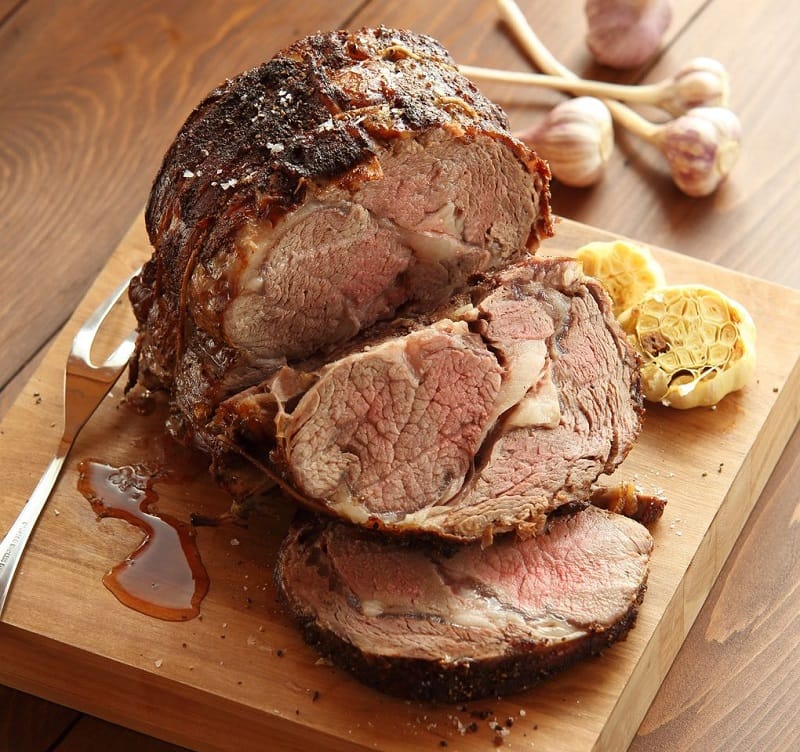
Prime rib and rib roast are both cuts of beef, but there are a few differences between them that you should be aware of before purchasing or cooking.
- Preparation: When it comes to practice, prime rib is the more expensive of the two. Prime rib is a boneless cut of beef from the rib primal, while rib roast is a bone-in cut that includes both the ribeye and the rib primal. Both cuts require trimming and the removal of the fat cap before cooking.
- Cooking Methods: The most common method is roasting when cooking either prime rib or rib roast. Prime rib is often roasted at a lower temperature to ensure the fat is rendered and the meat is cooked evenly. The rib roast is usually cooked at higher temperatures for a crisp, golden-brown crust.
- Serving Size: When it comes to serving size, prime rib is usually larger than rib roast. Prime rib typically comes in cuts of 4-7 ribs, while rib roast is usually just 2-3 ribs. The larger prime rib makes it a better choice for large gatherings or family dinners.
FAQs About Prime Rib vs Rib Roast
What Is The Recommended Internal Temperature For Prime Rib And Rib Roast?
The recommended internal temperature for these cuts of beef varies based on the preferred level of doneness. For medium-rare, the prime rib should reach 115 to 120°F, while for medium, it should be between 125 to 130°F. Similarly, for a rib roast, the recommended internal temperature for medium-rare is 130 to 134°F, and for medium, it is 135 to 140°F.
It is essential to check the temperature with a meat thermometer and place it in the thickest part of the beef, not touching the bone or fat. To ensure optimal flavor and texture, removing the prime rib roast from the oven when it reaches a temperature of 120-125°F and letting it rest for about 15-20 minutes is recommended. During this time, the internal temperature will continue to rise, reaching the desired temperature and allowing the juices to redistribute throughout the meat.
Is It Better To Cook Prime Rib Or Rib Roast Bone-In Or Boneless?
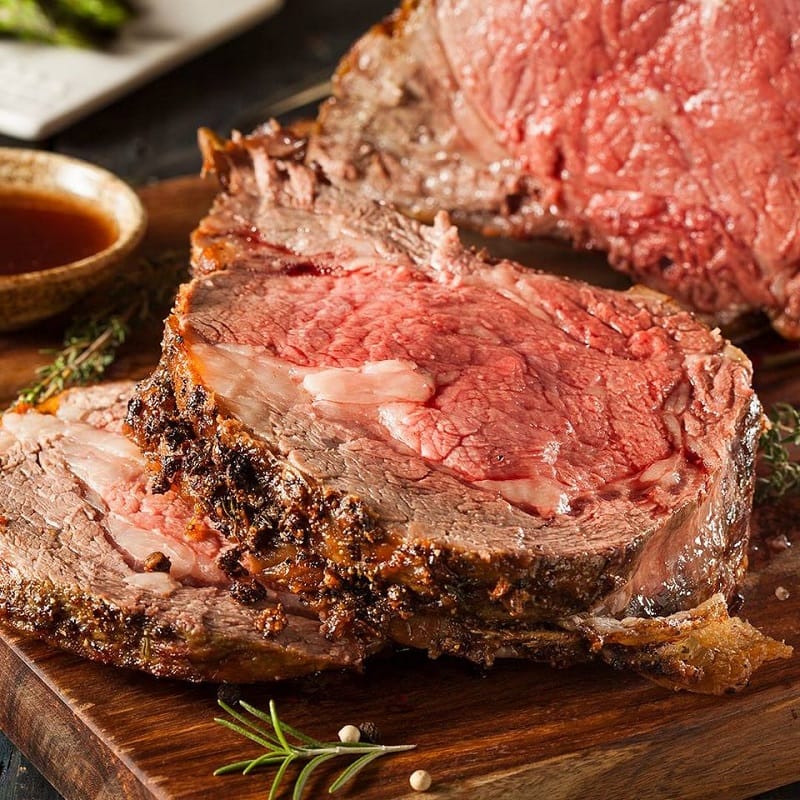
When cooking prime rib or rib roast, many people debate whether to choose bone-in or boneless, and there’s no right answer – it all comes down to personal preference. Bone-in meat is generally cheaper and has a richer flavor due to the bones adding moisture and flavor, but it can be trickier to carve. Boneless meat is easier to handle and sculpt but tends to be more expensive.
Regardless of your choice, prime rib and rib roast are delicious cuts of meat that are relatively easy to cook if you follow the appropriate temperature and cooking time guidelines. So whether you prefer boneless meat’s convenience or bone-in meat’s flavor, both options are fantastic for any special occasion.
Does The Amount Of Marbling Affect The Taste And Quality Of Prime Rib And Rib Roast?
Marbling significantly affects the taste and quality of these cuts of beef. Marbling refers to the amount of fat interspersed in the muscle fibers, adding flavor, tenderness, and juiciness to the meat. The more marbling a piece of meat has, the better its eating experience will be. When choosing a roast, one should look for the most tender, flavorful, and juiciest meat, typically with the most marbling—Prime grade.
However, if one chooses to dry-age a beef rib roast, one should be aware of the risk of ruining the expensive cut of meat or not liking the resulting flavor. Nevertheless, a well-marbled steak promises extraordinary juiciness and robust flavor beyond compare.
What Are Some Popular Seasoning Or Rubs For Prime Rib And Rib Roast?
One popular seasoning for prime rib is kosher salt, which is mixed with dried thyme, rosemary, and black pepper to create a simple yet flavorful rub. Another option is to mix coarse salt, black pepper, and garlic powder to create a seasoning that can be applied generously to cover every inch of the meat. A tasty option is a dry rub made with black pepper, smoked paprika, mustard powder, granulated garlic, and fresh rosemary.
Whether you prefer a simple seasoning or a complex rub, the right combination of spices can transform a plain piece of meat into a mouth-watering feast.
How Long Should You Allow The Meat To Rest After Cooking Prime Rib Or Rib Roast?
When perfecting prime rib, allowing the meat to rest after cooking is just as important as cooking it properly in the first place. It is recommended to allow the prime rib to rest at room temperature for around 30 minutes. This resting period allows the juices to redistribute throughout the meat, resulting in a more tender and flavorful final product.
The roast will continue to cook for up to 20 minutes after being removed from the oven, making it important to factor in this additional cooking time when determining the perfect internal temperature. So, for those looking to achieve the perfect prime rib, remember to give it the proper rest it deserves before diving in.
Conclusion
In conclusion, Prime Rib and Rib Roast are two distinct cuts of beef. Prime Rib is cut from the rib section of the animal and is usually well-marbled. Rib Roast, on the other hand, is cut from the back of the animal and is usually leaner. Both cuts have their place in the kitchen and can be cooked in different ways to create a delicious dish. In the end, it is up to the individual to decide which cut of beef they prefer. Prime Rib vs Rib Roast — no matter which one you choose, you can be sure you will get a delicious meal.
References:
- https://www.washingtonpost.com/lifestyle/food/forget-the-bones-and-other-secrets-to-the-perfect-holiday-rib-roast/2015/12/10/25096d30-9d00-11e5-bce4-708fe33e3288_story.html
- https://www.seriouseats.com/how-to-make-perfect-prime-rib-for-christmas-dinner
- https://www.ncbi.nlm.nih.gov/pmc/articles/PMC8100480/
- https://www.thespruceeats.com/biggest-mistakes-when-cooking-prime-rib-4177715

Hey readers! Chip Holland here, and I’m a Manager of this website. My passion for writing about it only matches my passion for BBQ. Follow my blog for mouth-watering recipes, tips, and tricks for the perfect smoke, grill, and BBQ. I’m sure you won’t be disappointed!
